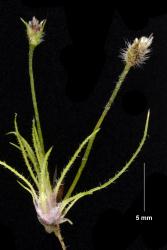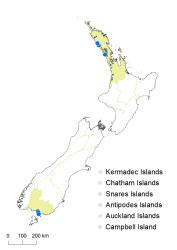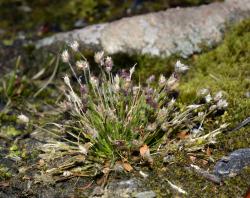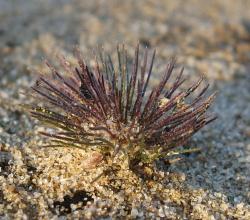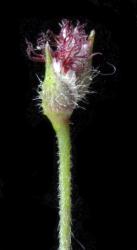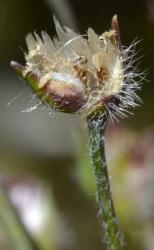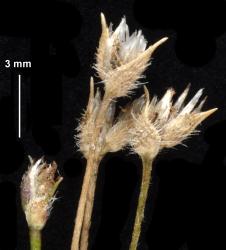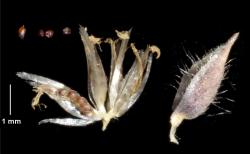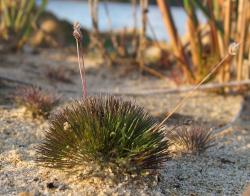- Taxon
- Gallery
- ≡ Devauxia strigosa R.Br., Prodr. Fl. Nov. Holland. 252 (1810)
Annual tuft, 15–80 mm high. Stem internodes condensed and not discernible. Leaves spiral, appearing radical, spreading. Leaf-sheath 1.6–5.5 mm long, hyaline, with multicellular hispid hairs. Leaf-sheath auricles absent; aligulate. Leaf-lamina 5–25 × 0.2–0.48 mm, filiform, with an acicular apex, terete, with multicellular hispid hairs. Uppermost leaf reduced to a membranous cataphyll. Flowering stems 10–65 mm long, surface retrorsely pilose. Inflorescence an ovoid spike, 3–4 × 1.5–5 mm. Outer primary floral bract 2.6–4 mm long, ovate and contracting to a short, spreading, glabrous foliar point, covered with multicellular hispid hairs; hyaline margins ciliate. Inner floral bract, 2.5–3.6 mm long, ovate and contracting to a short, spreading, glabrous foliar point, covered with multicellular hispid hairs; hyaline margins ciliate. Primary bracts separated by an internode 0.5–1.2 mm long. Secondary hyaline scales present, 2 or 3/reproductive unit. Reproductive units/spike (4)–13–(15), all bisexual. Androecium 1 stamen; filament capillary, 2–3 mm long; anthers ellipsoid, 0.5–1 mm long. Gynoecium 3–9 connate, superposed carpels. Styles stigmatic with simple papillae, crimson. Seeds 0.4–0.6 × 0.23–0.3 mm, obovoid, yellow-brown or red-brown, smooth to faintly striated.
Distinguished from all other centrolepids in New Zealand by a complete covering of hairs over the leaves, flowering stem and inflorescence bracts. Centrolepis strigosa is most similar to C. fascicularis, but that species does not have the retrorse pilose hairs on the flowering stem and the leaf-lamina is mostly glabrous with just a few hairs on the lower lamina.
North Island: North Auckland, Kai Iwi Lakes: Kai Iwi, Taharoa and Waikere, inland from Baylys Beach near Dargaville, Lake Ototoa, South Head, Kaipara Harbour.
South Island: Southland, The Bluff/Motupōhue summit and Sandy Point at the New River Estuary, Invercargill.
Indigenous to Australia, occurring in six states: Western Australia, South Australia, Queensland, New South Wales, Victoria and Tasmania (Cooke 1992).
Wet coastal sand, sandy-peat, shores of dune lakes, open coastal heathland; infertile soils, from sea level to 260 m a.s.l.
Flowering: Nov.-Feb.
There are three subspecies of C. strigosa indigenous to Australia; populations in New Zealand are referable to C. strigosa subsp. strigosa.
In New Zealand C. strigosa has been treated as both indigenous (Cheeseman 1925; Moore & Edgar 1970) and naturalised (Healy & Edgar 1980). Healy & Edgar (1980) changed its biostatus to naturalised on the basis of a wide disjunction in distribution following a discovery in late 1970 (Mason & Esler, 1970) from heathland near Dargaville - the other populations being at Bluff (Kirk, 1890) and 15 km away at Sandy Point near Invercargill (Poole, 1940). Subsequently over the last four decades it has been collected north of Dargaville at the Kai Iwi Lakes and south of Dargaville at Lake Ototoa on the South Kaipara Peninsula.
The arrival of C. strigosa in New Zealand is likely to have been recent and a hypothesis of arrival from Australia associated with human activity cannot easily be discarded. It has a limited presence here and its lack of discovery from unmodified habitats and away from areas of settlement, suggests either direct human introduction or establishment via trans-Tasman bird migration into human-modified habitats. Both the Southland and North Auckland populations are in areas of early European settlement and disturbance: in Southland, a major port and town (Bluff and Invercargill) and in the Dargaville area associated with gum-diggings in coastal heathlands. However, these places are also obvious ports-of-call for trans-Tasman birds, e.g. dune-lakes, a promontory and an estuary sand-spit. An interpretation of C. strigosa as part of an ‘indigenous vagrant flora’ is favoured here although human activity has probably assisted its establishment. Arrival into New Zealand coastal habitats via oceanic bird transport from south-eastern Australian populations is a likely scenario given its minute seeds and habitat preferences.
Although the known distribution of C. strigosa in North Auckland has widened to c. 90 km of the west coast, the South Island populations at The Bluff/Motupōhue and Sandy Point, the former dating back to 1890, appear to have remained localised.



